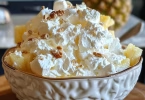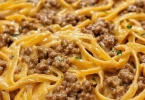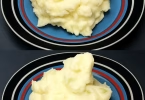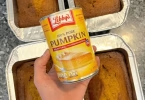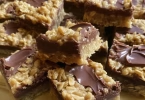Old Fashioned Pancakes — The Ultimate Long-Form Guide
There’s something quietly magical about a stack of Old Fashioned Pancakes: warm, pillowy centers, edges kissed golden and crisp, and that comforting aroma that turns a morning into an event. This long-form guide goes beyond a quick recipe — you’ll learn the why behind each ingredient, master precise technique, troubleshoot common problems, discover smart make-ahead and freezing methods, and explore creative variations so you can confidently make perfect pancakes every time.
What Makes These Pancakes “Old Fashioned”?
Old Fashioned Pancakes are rooted in simplicity: a handful of pantry staples — all-purpose flour, baking powder, a little sugar, milk, egg, butter, and salt — combined in a way that prioritizes texture and flavor. Unlike modern recipes that rely on buttermilk or complex techniques, the classic approach delivers a reliably fluffy, tender pancake with a neutral canvas that welcomes any topping from maple syrup to berries and whipped cream.
Ingredients (with roles explained)
- 1 ½ cups all-purpose flour — provides the structural proteins (gluten) that hold air and give body. Using all-purpose keeps pancakes tender while still forming a stable crumb. For nuttier flavor, part-swap with whole-wheat, but expect denser results.
- 3 ½ teaspoons baking powder — the primary leavener. It creates tiny gas bubbles for lift and a light crumb. Use fresh baking powder (less than 6 months old) for best rise.
- 1 tablespoon white sugar — a small amount sweetens and helps brown the exterior. Sugar also tenderizes slightly by competing for water with gluten.
- ¼ teaspoon salt — essential for flavor balance and to enhance the other ingredients. Salt also tightens gluten just enough to improve texture.
- 1 ¼ cups milk — hydrates the dry ingredients and dissolves sugar and salt. Whole milk gives richness; low-fat milks thin the batter slightly. For a subtle tang, use buttermilk (see variations).
- 3 tablespoons butter, melted — adds richness and flavor; the fat shortens gluten strands for tenderness and promotes a golden crust. Melted butter also contributes to mouthfeel.
- 1 large egg — binds ingredients and adds protein, which helps pancakes set and brown. The yolk adds richness; the white contributes to structure when cooked.
Step-by-Step Instructions — Master the Technique
Follow this method exactly the first time; once you understand the mechanics, you can adapt and riff.
- Sift and combine dry ingredients. In a large bowl, sift together the flour, baking powder, sugar, and salt. Sifting removes lumps and aerates the flour for a lighter batter.
- Whisk wet ingredients. In a separate bowl, whisk together the milk, melted butter (cooled slightly so it won’t cook the egg), and the egg until uniform.
- Make the batter. Create a shallow well in the dry ingredients and pour in the wet mixture. Stir gently with a flexible spatula or whisk until just combined. A few small lumps are fine — overmixing develops gluten and yields dense pancakes.
- Rest (optional but recommended). Let the batter rest 5–15 minutes. Resting hydrates starches and lets baking powder start working; it often results in lighter pancakes.
- Preheat your griddle. Heat a nonstick skillet or griddle over medium. Test readiness by flicking a few drops of water — they should dance and evaporate. Lightly oil or butter the surface; wipe excess fat with a paper towel so pancakes don’t fry in a pool of butter.
- Scoop and cook. Use a ¼-cup measure to pour batter into the hot pan, leaving space between pancakes. Cook until bubbles form and the edges look set (about 2–3 minutes), then flip and cook another 1–2 minutes until golden and cooked through.
- Keep warm and serve. If making a large batch, keep cooked pancakes on a wire rack in a 200°F oven to preserve texture while finishing the rest. Serve immediately hot with chosen toppings.
Troubleshooting — Fix Common Problems
Pancakes are flat
If pancakes don’t rise, check your baking powder (replace if old). Don’t overmix — vigorous stirring deflates bubbles. Also ensure the griddle is hot enough; batter that sits on a cool pan will spread too thin.
Pancakes are dense or gummy
Overmixing or using too much liquid can create a gummy texture. Use the recommended milk measure and stir until just combined. Rest the batter briefly to let flour hydrate properly; this prevents gummy interiors.
Edges burn before centers cook
Reduce heat slightly; the pan may be too hot. Use a medium setting and allow the griddle to come to temperature gradually — cast iron retains heat strongly and may need a lower setting.
Too greasy
Wipe excess oil between batches. A light film of fat is enough; you want a golden surface, not a fried texture. Use clarified butter or neutral oil for a cleaner finish.
Pro Tips for Restaurant-Quality Pancakes
- Temperature control: Aim for an even medium heat. Hot enough to brown in 2–3 minutes per side but not so hot the exterior burns before the center sets.
- Measure precisely: Use measuring cups and spoons. Small deviations in flour or baking powder affect texture significantly.
- Let the batter rest: 10 minutes lets the leavening activate and creates a smoother batter.
- Use a ladle or portion cup: For uniform pancakes that stack neatly and cook evenly.
- Buttery finish: Add a small pat of butter on top of a hot stack — it melts and adds gloss and flavor.
- Make-ahead magic: Freeze cooked pancakes in single layers on a sheet pan, then store in freezer bags. Reheat in the oven or toaster for quick mornings.
Creative Variations
Once you’ve mastered the base, try these delicious riffs:
- Buttermilk pancakes: Substitute the milk with equal buttermilk and reduce baking powder to 2 tsp; add 1 tsp baking soda for tang and lift.
- Blueberry pancakes: Fold 3/4 cup fresh or lightly floured frozen blueberries into the batter just before scooping.
- Banana pancakes: Mash one ripe banana and fold into wet ingredients for natural sweetness.
- Whole wheat: Use half whole-wheat flour and half all-purpose; add an extra tablespoon of milk if batter seems dry.
- Protein pancakes: Add 1/3 cup protein powder and reduce flour by 1/3 cup; adjust liquid as needed.
Serving Suggestions & Pairings
Old Fashioned Pancakes are an endlessly adaptable canvas. Here are pairing ideas to turn a simple stack into a memorable meal:
- Classic: Warm maple syrup and butter.
- Bright & fresh: Greek yogurt, honey, and a scattering of sliced strawberries or mixed berries.
- Decadent: Nutella or chocolate-hazelnut spread, banana slices, and toasted hazelnuts.
- Savory stack: Serve with crispy bacon or smoked salmon, crème fraîche and chives for a brunch-worthy twist.
- Beverage pairings: Freshly brewed coffee, latte, freshly squeezed orange juice, or a mimosa for celebrations.
Storage, Freezing & Make-Ahead Tips
Cooked pancakes: Cool completely, then layer between sheets of parchment in an airtight container for up to 3 days in the fridge. Freeze single layers on a baking sheet for 1–2 hours, then stack in freezer bags for up to 2 months.
Reheating: Reheat frozen pancakes in a 350°F oven on a wire rack for 8–12 minutes, or pop them in the toaster for 1–2 cycles for a crisp edge.
Batter freezing: Portion batter into freezer bags (¼-cup portions), freeze flat up to 1 month. Thaw overnight in the fridge, stir gently and cook.
Final Notes — Why This Recipe Works
This Old Fashioned Pancake method is built on dependable science: measured ingredients, gentle mixing, correct heat, and the right balance of fat and liquid. It’s forgiving, flexible, and designed for consistent results so you can reproduce the same light, golden pancakes again and again. Whether you’re making a simple weekday breakfast or a leisurely weekend brunch, these pancakes offer comfort, nostalgia, and delicious versatility.
Make them your own: Start with the classic, master the technique, then personalize with your favorite add-ins and toppings. With practice you’ll know by feel and sight when the batter and heat are perfect — then every stack will be restaurant-quality.
Quick Recipe Card
Ingredients:
- 1 ½ cups all-purpose flour
- 3 ½ teaspoons baking powder
- 1 tablespoon white sugar
- ¼ teaspoon salt
- 1 ¼ cups milk
- 3 tablespoons butter, melted
- 1 large egg
Method: Sift dry ingredients → Whisk wet → Combine and stir until just mixed → Rest 5–15 minutes → Cook on medium griddle 2–3 min per side → Serve hot.


